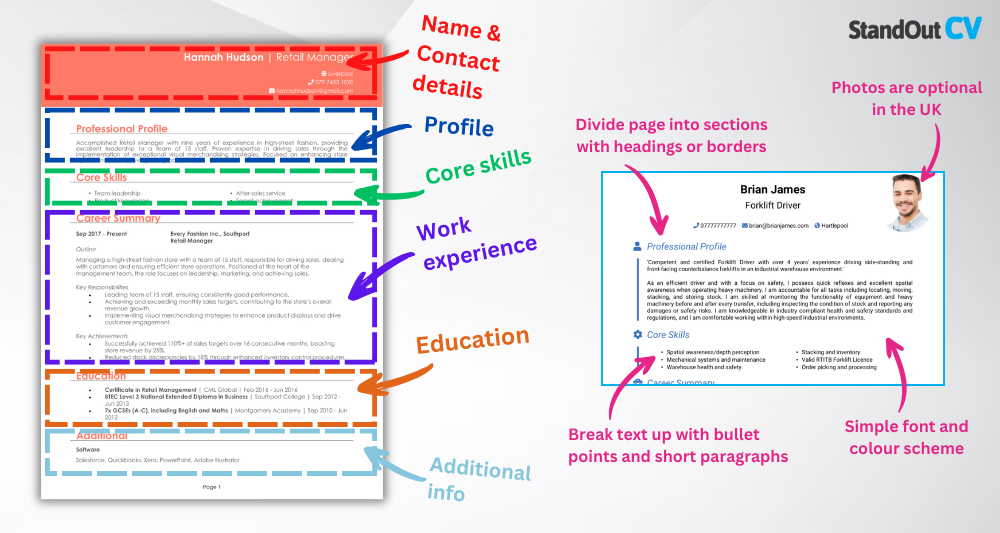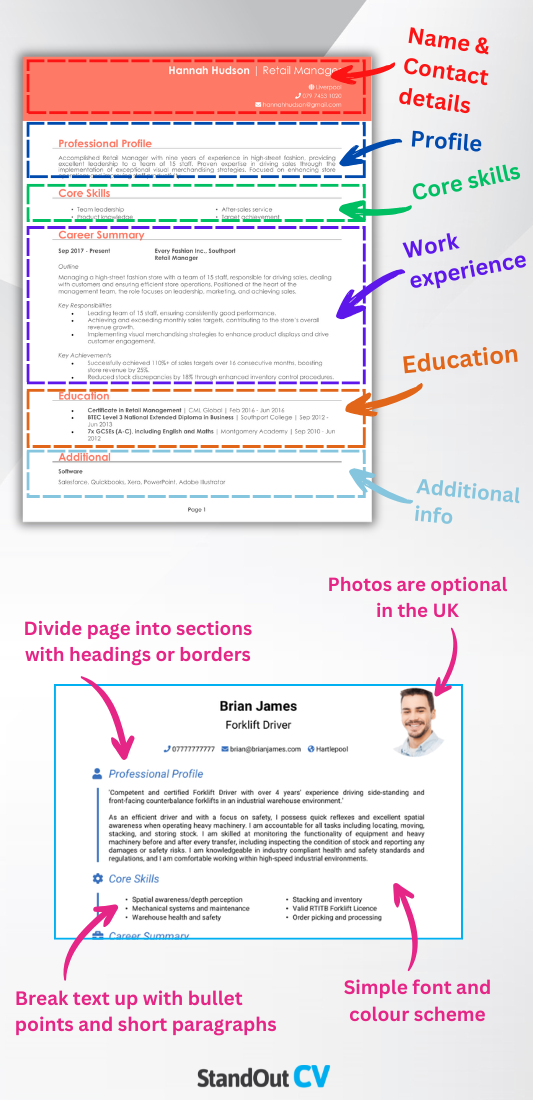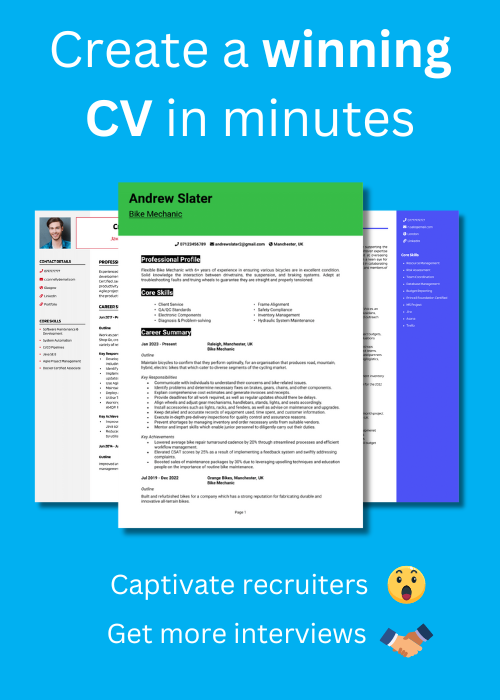You know your way around plaque and polish, but polishing your CV might feel like pulling teeth. Your CV needs to show not only your clinical skill but your reassuring chairside manner.
This guide will help you polish your CV until it shines. With expert advice and a Dental Hygienist CV example, you’ll learn how to highlight your qualifications and demonstrate your patient care experience to secure more interviews in the dental field.
Dental Hygienist CV sample

How to write your Dental Hygienist CV
Discover how to craft a winning Dental Hygienist CV that lands interviews with this simple step-by-step guide.
No one likes a rushed appointment – and no recruiter likes a rushed CV either. This guide breaks down writing a CV that reflects both your technical abilities and your personal care approach.
From formatting to content, this guide shows you how to craft a CV that feels professional, patient-centred, and perfect for the next step in your dental career.
The correct structure and formatting for a Dental Hygienist CV


If your CV is difficult to read or full of mistakes, it’s not getting a follow-up appointment. Hiring managers want to instantly see your qualifications, hygiene experience, and patient care strengths without needing to floss through dense paragraphs. Your structure should effortlessly guide them through each section, to help them understand your value.
Here’s the layout to follow:
- Name and contact details – Start with your name and personal details – make it simple for recruiters to reach you. Including a photo is a personal choice.
- Profile – Use this section to summarise your experience, strengths, and what makes you a standout candidate.
- Core skills – Outline your primary competencies to give recruiters a snapshot of your strengths.
- Work experience – Walk through your professional experience, beginning with your latest position and moving backwards.
- Education – Outline your education and certifications, focusing on those most relevant to the role.
- Additional info – This section is optional, but it’s a good place for interests and hobbies that complement your CV.
Keep the format clean and consistent. Use bullet points in each section to highlight your contributions clearly and break up walls of text. Make sure each section is divided with clear headings, and choose a professional font that’s easy to read. Most importantly, keep the CV length to two pages or less – it should be thorough but not overwhelming.
CV profile for a Dental Hygienist


This short paragraph is your opportunity to quickly highlight the value you bring to any dental practice. It should communicate your clinical expertise and your ability to deliver quality care to patients.
The focus in your CV profile is on the benefits you provide – not just your tasks, but your impact on patient outcomes and the practice environment. Write it with the patient and employer in mind.
Dental Hygienist CV profile examples
Profile 1
Experienced Dental Hygienist with over 12 years of experience supporting NHS and private dental practices. Skilled in delivering routine cleanings, periodontal therapy, and oral health education. Committed to patient comfort and preventive care, with strong rapport-building and cross-team collaboration.
Profile 2
Compassionate Dental Hygienist with eight years of experience working in high-volume clinics and cosmetic dental practices. Adept at conducting scale and polish procedures, charting periodontal conditions, and advising patients on tailored oral hygiene routines. Confident using SOE and digital radiography systems.
Profile 3
Diligent Dental Hygienist with five years of experience delivering chairside care and oral hygiene treatments across mixed practices. Focused on educating patients, supporting treatment planning, and maintaining meticulous infection control standards. Known for calm, reassuring patient communication.
Details to put in your Dental Hygienist CV profile
Your profile should include:
- Where you worked – Specify the types of clinics, dental surgeries, or healthcare environments you’ve worked in to give recruiters context for your experience.
- Your top qualifications – Mention your dental hygiene qualification and any additional certifications to demonstrate you meet professional standards.
- Essential skills – Highlight your ability to perform hygiene treatments effectively, provide oral health education, and maintain infection control protocols.
- Patient types or special settings – Indicate if you’ve worked with children, nervous patients, or those requiring specialist care, to show your adaptability.
- Value delivered – Emphasise how you’ve improved patient outcomes, supported practice efficiency, or helped boost retention and satisfaction.
How should you write a core skills section?


Your core skills section should offer a snapshot of your clinical competence and regulatory awareness – all based on what employers expect to see in the role.
Instead of soft generalisations, focus on tangible abilities like periodontal assessments, scaling and polishing, charting, patient education, and infection control. You can also reference your knowledge of dental software systems or NHS compliance. Match your terminology and focus to the role you’re applying for, and avoid repetition or vague traits.
Key skills for a Dental Hygienist CV
- Oral Health Assessments – Conducting thorough examinations of patients’ teeth and gums to detect signs of disease or decay.
- Scaling and Polishing Procedures – Removing plaque, tartar, and stains from teeth to prevent gum disease and maintain oral hygiene.
- Periodontal Therapy – Treating and managing gum conditions such as gingivitis and periodontitis through deep cleaning and maintenance.
- Patient Education and Preventive Care – Advising patients on proper brushing, flossing techniques, and diet to support long-term oral health.
- Fluoride and Sealant Application – Applying preventive treatments to strengthen enamel and protect against tooth decay.
- Dental Charting and Record Keeping – Documenting clinical findings, treatment plans, and patient progress accurately.
- Infection Control and Sterilisation – Following strict hygiene protocols to sterilise equipment and maintain a safe clinical environment.
- Radiograph Taking and Interpretation – Capturing and reviewing dental X-rays to support diagnosis and treatment planning.
- Collaboration with Dental Team – Working closely with dentists and dental nurses to coordinate patient care and referrals.
- Pain and Anxiety Management – Using calming techniques and local anaesthesia where appropriate to ensure patient comfort during procedures.
Writing about your work experience


Your work experience is where you can really demonstrate how your hygiene skills translate into quality patient care and practice success. Talk the recruiter through your roles in reverse chronological order.
Each entry should begin with a short summary of the dental practice and your role there, followed by bullet points detailing your day-to-day responsibilities and achievements. Highlight the treatments performed, the types of patients treated, and any special initiatives you supported.
If you helped streamline scheduling, introduced new patient education methods, or improved treatment outcomes, this is the place to say it.
Formatting your job history for your CV

- Outline – Describe the type of dental practice or clinic, your role within the team, and the patient base you served.
- Responsibilities – Use action words like “delivered” and “monitored.” For example: “delivered preventative hygiene treatments” or “monitored oral health plans for long-term patients.” Include tools, techniques, and patient interactions.
- Achievements – Highlight positive results like increased patient retention, improved oral health outcomes, or process improvements in hygiene or infection control.
Work experience samples for Dental Hygienists
Dental Hygienist | Claredon Dental Studio
Outline
Provided preventative and periodontal care for patients in a private dental practice, supporting cosmetic and general treatment plans with a focus on oral health education.
Responsibilities
- Performed scaling, polishing, and debridement procedures to treat and prevent gum disease
- Assessed periodontal health and recorded BPE scores in patient records
- Delivered oral hygiene instruction tailored to individual patient needs
- Sterilised instruments and adhered to infection control protocols
- Collaborated with dentists on treatment planning and patient care reviews
Achievements
- Improved patient compliance with oral care routines, reducing follow-up needs by 22%
- Maintained a 98% patient retention rate through strong rapport and education
- Streamlined hygiene appointment scheduling, reducing admin time by 30%
Dental Hygienist | Southgate NHS Dental Centre
Outline
Delivered routine hygiene treatments and periodontal assessments for NHS patients in a busy, multi-chair dental practice.
Responsibilities
- Conducted scale and polish treatments and provided non-surgical periodontal therapy
- Explained gum disease diagnosis and preventive techniques in accessible language
- Maintained up-to-date clinical notes using SOE dental software
- Assisted with triage and urgent care where needed during high-demand periods
- Supported newly qualified staff with protocol training and patient management
Achievements
- Reduced late cancellations by 35% by enhancing appointment reminder system
- Contributed to practice’s 5-star NHS rating through consistent patient feedback
- Recognised by practice lead for calm handling of nervous and vulnerable patients
Dental Hygienist | Oakridge Dental & Implant Centre
Outline
Supported implant and cosmetic dentistry cases at a high-end private clinic, ensuring high standards of patient care and compliance.
Responsibilities
- Carried out hygiene treatments pre- and post-implant placement as part of long-term care
- Monitored plaque levels and gum condition using full periodontal charting
- Provided dietary and lifestyle advice to support patients with specific oral health risks
- Ensured full compliance with CQC and GDPR guidelines in record-keeping and patient care
- Assisted dentists with aesthetic case documentation and patient education
Achievements
- Helped reduce post-treatment complications in implant patients by 18%
- Generated positive word-of-mouth leading to a 12% increase in hygiene bookings
- Implemented patient recall system for high-risk cases, improving continuity of care
How to write your education section


You’ve already survived dental school – this part should be painless. A recognised dental hygiene qualification is essential, and this section is where you show you meet the regulatory standards. Whether you studied through a diploma programme or obtained a full degree, this information reassures employers that you’re professionally trained.
Start with your most recent or highest qualification and keep the wording simple and clear. You might also mention CPD training or short courses. If you’re newly qualified, you can expand slightly on your past education, or any placement work.
Recommended qualifications for Dental Hygienists
- Diploma in Dental Hygiene – A standard requirement for practicing hygienists in the UK
- BSc in Oral Health Science – Combines hygiene and therapy training for broader clinical scope
- GDC Registration – Mandatory for working legally in dental settings
- CPD in Infection Prevention & Control – Reinforces your ability to work safely and to NHS or private standards
- Certificate in Dental Radiography (if applicable) – Allows you to take radiographs if your practice requires it





